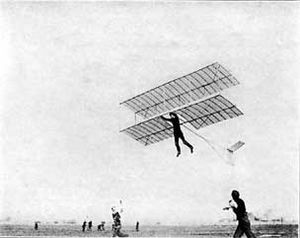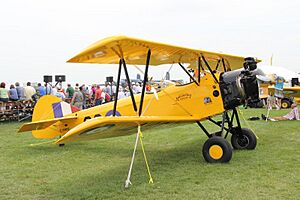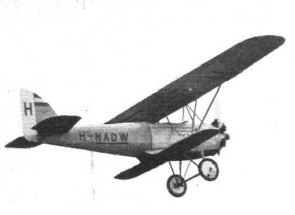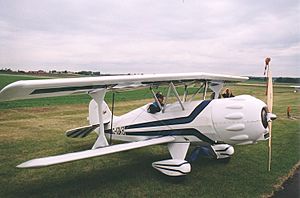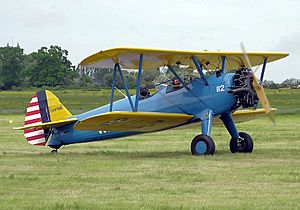Biplane facts for kids
A biplane is a special type of Fixed-wing aircraft that has two main wings, one placed above the other. Imagine stacking two airplane wings! This design makes them very strong and light for their size. However, having two wings also creates more air resistance compared to planes with just one wing.
Biplanes can usually lift more weight than similar planes with a single wing (called monoplanes). In most biplanes, the lower wing is attached to the plane's body, and the top wing is held up by special supports. Almost all biplanes also have a tail wing to help them steer.
Some famous biplanes you might have heard of include the Sopwith Camel, Antonov An-2, Boeing Stearman, and the Wright Flyer. The Stearman is especially known for amazing stunt flying, like when people walk on its wings while it's in the air!
Contents
How Biplanes Work
Understanding Biplane Wings
In a biplane, the two wings are stacked one above the other. Both wings help create lift, which is the force that pushes the plane up into the air. Even though there are two wings, they don't produce twice as much lift as a single wing of the same size. This is because the air around the top wing and bottom wing can get in each other's way a little bit.
The lower wing is usually connected to the main body of the plane (called the fuselage). The upper wing is held above the fuselage by special poles called cabane struts. Both wings can have parts that move, like ailerons, which help the plane roll. Flaps, which help with slowing down, are usually on the lower wing. Strong wires and thin poles, called interplane struts, connect the upper and lower wings to make the structure even stronger.
Why Biplanes Were Used
The main reason biplanes were popular was their amazing strength and light weight. Imagine a strong box – that's kind of how a biplane's wing structure works! This "box" shape makes them naturally very strong and easy to build without being too heavy. The two wings help support each other, making the whole plane stiffer.
Early airplane engines weren't very powerful, so planes couldn't fly very fast. They needed to be able to fly slowly without falling out of the sky. This meant they needed large wings to create enough lift. A biplane could have twice the wing area of a monoplane of the same size, allowing it to fly slower or carry more weight. Or, for the same wing area, a biplane could be smaller and lighter.
Challenges of Biplanes
Biplanes do have a downside: the two wings can interfere with each other's airflow. This means they don't get quite double the lift of a single wing. The farther apart the wings are, the less this happens, but then the connecting poles need to be longer.
In the early days of aviation, the extra drag from the wires and poles, and the slight airflow interference, weren't a big problem because planes were slow anyway. But as engines became more powerful after World War I, planes could fly much faster. The extra drag from the biplane's structure became a real issue. This is why single-wing planes (monoplanes) started to become more common after 1918, as they could fly faster with less drag.
However, the smaller wings of a biplane make them very good at turning quickly. This was a huge advantage during World War I for military planes. Even today, some special sports planes used for amazing aerobatic tricks are still biplanes because of their great maneuverability.
Wing Stagger
When biplanes were first designed, the wings were usually stacked directly one above the other. But designers found that moving the top wing slightly forward of the lower wing, called positive stagger, could actually help the plane fly better. It can increase lift and reduce drag by improving how air flows around the wings. Many biplanes have this staggered wing design.
Sometimes, the lower wing's front edge is placed ahead of the upper wing. This is called negative stagger. It's less common and usually done for specific design reasons. Examples include the Sopwith Dolphin and the Beechcraft Staggerwing. Positive stagger is more popular because it also gives the pilot a better view and makes it easier to get into the cockpit.
Different Types of Biplanes
The space between the wings, held by connecting poles (interplane struts), is called a bay.
- A single-bay biplane has one set of these poles connecting the wings on each side. This was strong enough for smaller planes like the Fokker D.VII fighter from World War I or the de Havilland Tiger Moth trainer from World War II.
- Larger planes, like the two-seat Curtiss JN-4 Jenny, needed more strength, so they were two-bay biplanes. This means they had two sets of connecting poles on each side.
- Very large transport or bombing biplanes sometimes needed even more bays and are called multi-bay biplanes.
- A few rare biplanes, like the Zeppelin-Lindau D.I, had no interplane struts at all and are called strutless biplanes.
-
The SPAD S.XIII was a single-bay biplane with extra bracing.
Sesquiplanes
A sesquiplane is a special kind of biplane where one wing (usually the lower one) is much smaller than the other, often less than half its size. The name "sesquiplane" means "one-and-a-half wings." This design can help reduce the air interference between the wings while still keeping the biplane's strong structure.
A good example is the Pander E from the 1920s, which had a lower wing exactly half the length of the upper wing. Many Nieuport military planes from World War I, like the Nieuport 17, were also sesquiplanes. They had upper and lower wings that were almost the same length, but the lower wing was much narrower.
Ultralight Biplanes
Most ultralight aircraft (very light, simple planes) are monoplanes. However, because ultralights fly slowly and are built simply, some biplane ultralights have been designed. One example is Larry Mauro's Easy Riser from 1975. He even made a version called the Solar Riser that ran on solar power!
Other ultralight biplanes include the Belgian Aviasud Mistral and the German FK12 Comet.
History of Biplanes
The idea for the biplane came from the box kite, which was invented by an Australian named Lawrence Hargrave. By 1896, Octave Chanute was flying biplane hang gliders and believed that biplanes were better for powered flight than monoplanes. The famous Wright Flyer biplane, which made the first successful powered flight in 1903, proved him right!
In the early years of aviation, both biplanes and monoplanes were common. But by the start of World War I, biplanes became much more popular. This was partly because some early monoplanes had structural problems. For example, the British military even banned monoplanes from service for a while.
From 1914 to about 1925, most new aircraft were biplanes. However, by 1918, German engineers were already experimenting with new monoplanes that had less drag.
As airplane engines got more powerful and planes could fly faster, the drag from a biplane's external wires and poles became a big problem. To fly even faster, planes needed smoother wings without all the outside bracing. This led to the development of stronger, single-wing designs.
By the 1930s, biplanes had reached their limits in terms of speed and performance. Monoplanes became the main type of aircraft, especially in Europe. At the start of World War II, some air forces still used biplane combat planes, but they weren't as fast or powerful as the new monoplanes. Most biplanes were then used for special jobs, like training pilots or flying from aircraft carriers.
For example, the British Fairey Swordfish torpedo bomber biplane was used from aircraft carriers until the end of the war. It was great for hunting submarines because it could take off from smaller ships. The Soviet Polikarpov Po-2 was even used for night bombing during the Korean War!
Later biplane trainer planes included the de Havilland Tiger Moth and the Boeing Stearman. In civilian life, the Stearman became very famous for stunt flying, including wing-walking performances.
Today, biplanes are still built for special purposes like aerobatics (stunt flying) and as agricultural aircraft (crop dusters). The Pitts Special has been a top aerobatic biplane for many years, and the WACO Classic YMF is a modern version of an old Waco design.
Most biplanes have used regular piston engines. However, some newer versions of old biplanes, like the Antonov An-3, use turboprop engines, which are more powerful.
The two most produced biplane designs ever are the British Avro 504 (nearly 9,000 built) and the Soviet Polikarpov Po-2 (over 20,000 built!).
Biplanes in Nature
Scientists have suggested that the feathered dinosaur Microraptor might have glided, or even flown, using four wings! It had flight feathers on both its front and back legs, which could have worked like a biplane. This idea suggests that the earliest flying ancestors of birds might have had this "four-winged" design, and that modern birds with their single pair of wings developed later.
Images for kids
-
A World War I Sopwith Camel biplane.
-
The Gloster Gladiator, a World War II fighter biplane.
-
A Soviet Antonov An-2 biplane from the 1940s.
-
A late 1930s Fiat CR.42 Falco biplane.
-
A Polikarpov Po-2, one of the most produced biplanes ever.
See also
 In Spanish: Biplano para niños
In Spanish: Biplano para niños


